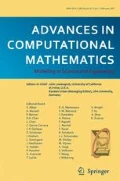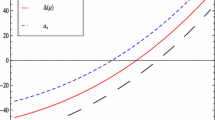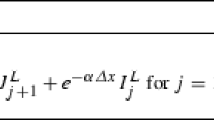Abstract
The eigenvalues and eigenfunctions of the Stokes operator have been the subject of intense analytical investigation and have applications in the study and simulation of the Navier–Stokes equations. As the Stokes operator is second order and has the divergence-free constraint, computing these eigenvalues and the corresponding eigenfunctions is a challenging task, particularly in complex geometries and at high frequencies. The boundary integral equation (BIE) framework provides robust and scalable eigenvalue computations due to (a) the reduction in the dimension of the problem to be discretized and (b) the absence of high-frequency “pollution” when using Green’s function to represent propagating waves. In this paper, we detail the theoretical justification for a BIE approach to the Stokes eigenvalue problem on simply- and multiply-connected planar domains, which entails a treatment of the uniqueness theory for oscillatory Stokes equations on exterior domains. Then, using well-established techniques for discretizing BIEs, we present numerical results which confirm the analytical claims of the paper and demonstrate the efficiency of the overall approach.
Similar content being viewed by others
References
Akhmetgaliyev, E., Bruno, O. P., Nigam, N.: A boundary integral algorithm for the laplace dirichlet–neumann mixed eigenvalue problem. J. Comput. Phys. 298, 1–28 (2015)
Alpert, B. K.: Hybrid gauss-trapezoidal quadrature rules. SIAM J. Sci. Comput. 20(5), 1551–1584 (1999)
Antunes, P.R.: On the buckling eigenvalue problem. J. Phys. A: Math. Theor. 44(21), 215205 (2011)
Ashbaugh, M. S., Laugesen, R. S.: Fundamental tones and buckling loads of clamped plates. Ann. della Scuola Normal. Super. Pisa-Classe Sci. 23(2), 383–402 (1996)
Babuska, I. M., Sauter, S. A.: Is the pollution effect of the FEM avoidable for the Helmholtz equation considering high wave numbers? SIAM J. Numer. Anal. 34 (6), 2392–2423 (1997)
Bäcker, A.: Numerical Aspects of Eigenvalue and Eigenfunction Computations for Chaotic Quantum Systems. In: The Mathematical Aspects of Quantum Maps, pp. 91–144. Springer (2003)
Barnett, A.: Asymptotic rate of quantum ergodicity in chaotic euclidean billiards. Commun. Pure Appl. Math. A J. Issued Courant Inst. Math. Sci. 59(10), 1457–1488 (2006)
Barnett, A., Betcke, T.: MPSpack: A MATLAB toolbox to solve Helmholtz PDE, wave scattering, and eigenvalue problems, pp. 2008–2012
Batcho, P. F., Karniadakis, G. E.: Generalized Stokes eigenfunctions: a new trial basis for the solution of incompressible Navier-Stokes equations. J. Comput. Phys. 115(1), 121–146 (1994)
Biros, G., Ying, L., Zorin, D.: The embedded boundary integral method for the unsteady incompressible Navier–Stokes equations. Tech. Rep. TR2003-838, Courant Institute, New York University. https://cs.nyu.edu/media/publications/TR2003-838.pdf (2002)
Bjørstad, P.E., Tjøstheim, B.P.: High precision solutions of two fourth order eigenvalue problems. Computing 63(2), 97–107 (1999). https://doi.org/10.1007/s006070050053
Bornemann, F.: On the numerical evaluation of fredholm determinants. Math. Comput. 79(270), 871–915 (2010)
Bramble, J., Payne, L.: Pointwise bounds in the first biharmonic boundary value problem. J. Math. Phys. 42(1-4), 278–286 (1963)
Bremer, J., Gimbutas, Z.: A nyström method for weakly singular integral operators on surfaces. J. Comput. Phys. 231(14), 4885–4903 (2012)
Bremer, J., Gimbutas, Z., Rokhlin, V.: A nonlinear optimization procedure for generalized Gaussian quadratures. SIAM J. Sci. Comput. 32(4), 1761–1788 (2010)
Bruno, O. P., Kunyansky, L. A.: A fast, high-order algorithm for the solution of surface scattering problems: basic implementation, tests, and applications. J. Comput. Phys. 169(1), 80–110 (2001)
Carstensen, C., Gallistl, D.: Guaranteed lower eigenvalue bounds for the biharmonic equation. Numer. Math. 126(1), 33–51 (2014)
Chen, W., Lin, Q.: Approximation of an eigenvalue problem associated with the Stokes problem by the stream function-vorticity-pressure method. Appl. Math. 51(1), 73–88 (2006)
Cheng, H., Gimbutas, Z., Martinsson, P. G., Rokhlin, V.: On the compression of low rank matrices. SIAM J. Sci. Comput. 26(4), 1389–1404 (2005)
Colton, D. L., Kress, R.: Integral equation methods in scattering theory. Pure and Applied Mathematics. Wiley, New York (1983)
Driscoll, T. A., Hale, N., Trefethen, L.N.: Chebfun guide (2014)
Epstein, C. L., O’Neil, M.: Smoothed corners and scattered waves. SIAM J. Sci. Comput. 38(5), A2665–A2698 (2016)
Filoche, M., Mayboroda, S.: Strong localization induced by one clamped point in thin plate vibrations. Phys. Rev. Lett. 103(25), 254301 (2009)
Halko, N., Martinsson, P. G., Tropp, J. A.: Finding structure with randomness: Probabilistic algorithms for constructing approximate matrix decompositions. SIAM Rev. 53(2), 217–288 (2011)
Helsing, J., Jiang, S.: On integral equation methods for the first Dirichlet problem of the biharmonic and modified biharmonic equations in nonsmooth domains. SIAM J. Sci. Comput. 40(4), A2609–A2630 (2018)
Helsing, J., Ojala, R.: Corner singularities for elliptic problems: Integral equations, graded meshes, quadrature, and compressed inverse preconditioning. J. Comput. Phys. 227(20), 8820–8840 (2008)
Helsing, J., Ojala, R.: On the evaluation of layer potentials close to their sources. J. Comput. Phys. 227(5), 2899–2921 (2008)
Ho, K.L.: FLAM: Fast linear algebra in MATLAB. https://doi.org/10.5281/zenodo.1253582 (2018)
Ho, K. L., Greengard, L.: A fast direct solver for structured linear systems by recursive skeletonization. SIAM J. Sci. Comput. 34(5), A2507–A2532 (2012)
Huang, P., He, Y., Feng, X.: Numerical investigations on several stabilized finite element methods for the Stokes eigenvalue problem. Mathematical Problems in Engineering 2011 (2011)
Jia, S., Xie, H., Yin, X., Gao, S.: Approximation and eigenvalue extrapolation of Stokes eigenvalue problem by nonconforming finite element methods. Appl. Math. 54(1), 1–15 (2009)
Jiang, S., Kropinski, M. C., Quaife, B. D.: Second kind integral equation formulation for the modified biharmonic equation and its applications. J. Comput. Phys. 249, 113–126 (2013)
Johnson, C. P., Will, K. M.: Beam buckling by finite element procedure. J. Struc. Div. 100(Proc Paper 10432), 669–685 (1974)
Kelliher, J.: Eigenvalues of the Stokes operator versus the Dirichlet laplacian in the plane. Pac. J. Math. 244(1), 99–132 (2009)
Kim, S., Karrila, S.J.: Microhydrodynamics: Principles and selected applications (1991)
Kimeswenger, A., Steinbach, O., Unger, G.: Coupled finite and boundary element methods for fluid-solid interaction eigenvalue problems. SIAM J. Numer. Anal. 52(5), 2400–2414 (2014)
Kirsch, A.: An integral equation approach and the interior transmission problem for maxwell’s equations. Inver. Probl. Imaging 1(1), 159 (2007)
Kitahara, M.: Boundary integral equation methods in eigenvalue problems of elastodynamics and thin plates, vol. 10 Elsevier (2014)
Klöckner, A., Barnett, A., Greengard, L., O’Neil, M.: Quadrature by expansion: a new method for the evaluation of layer potentials. J. Comput. Phys. 252, 332–349 (2013)
Kress, R.: Boundary integral equations in time-harmonic acoustic scattering. Math. Comput. Model. 15(3-5), 229–243 (1991)
Kress, R., Maz’ya, V., Kozlov, V.: Linear integral equations, vol. 17. Springer (1989)
Ladyzhenskaya, O. A.: The mathematical theory of viscous incompressible flow, vol. 76. Gordon and Breach, New York (1969)
Leriche, E., Labrosse, G.: Stokes eigenmodes in square domain and the stream function–vorticity correlation. J. Comput. Phys. 200(2), 489–511 (2004)
Lindsay, A. E., Quaife, B., Wendelberger, L.: A boundary integral equation method for mode elimination and vibration confinement in thin plates with clamped points. Adv. Comput. Math. 44(4), 1249–1273 (2018)
Lovadina, C., Lyly, M., Stenberg, R.: A posteriori estimates for the Stokes eigenvalue problem. Numer. Methods Partial Differ. Equ. 25(1), 244–257 (2009)
Lu, Y. Y., Yau, S. T.: Eigenvalues of the laplacian through boundary integral equations. SIAM J. Matrix Anal. Appl. 12(3), 597–609 (1991)
Mayergoyz, I.D., Fredkin, D.R., Zhang, Z.: Electrostatic (plasmon) resonances in nanoparticles. Phys. Rev. B 72(15), 155412 (2005)
Mercier, B., Osborn, J., Rappaz, J., Raviart, P. A.: Eigenvalue approximation by mixed and hybrid methods. Math. Comput. 36(154), 427–453 (1981)
Noferini, V., Pérez, J.: Chebyshev rootfinding via computing eigenvalues of colleague matrices: when is it stable? Math. Comput. 86(306), 1741–1767 (2017)
Osborn, J. E.: Approximation of the eigenvalues of a nonselfadjoint operator arising in the study of the stability of stationary solutions of the Navier–Stokes equations. SIAM J. Numer. Anal. 13(2), 185–197 (1976)
Overvelde, J. T., Shan, S., Bertoldi, K.: Compaction through buckling in 2d periodic, soft and porous structures: effect of pore shape. Adv. Mater. 24(17), 2337–2342 (2012)
Pólya, G., Pólya, G., Szegő, G.: Isoperimetric inequalities in mathematical physics. Princeton University Press (1951)
Pozrikidis, C.: Boundary Integral and Singularity Methods for Linearized Viscous Flow. Cambridge University Press, Cambridge. https://doi.org/10.1017/CBO9780511624124. http://ebooks.cambridge.org/ref/id/CBO9780511624124 (1992)
Rachh, M., Askham, T.: Integral equation formulation of the biharmonic Dirichlet problem. J. Sci. Comp. 75(2), 762–781 (2018)
Rachh, M., Serkh, K.: On the solution of S,tokes equation on regions with corners. arXiv:1711.04072 (2017)
Rannacher, R.: Nonconforming finite element methods for eigenvalue problems in linear plate theory. Numer. Math. 33(1), 23–42 (1979). https://doi.org/10.1007/BF01396493
Reed, M., Simon, B.: Methods of mathematical physics i: Functional analysis (1972)
Schneider, K., Farge, M.: Final states of decaying 2d turbulence in bounded domains: Influence of the geometry. Physica D: Nonlinear Phenom. 237(14-17), 2228–2233 (2008)
Serkh, K., Rokhlin, V.: On the solution of elliptic partial differential equations on regions with corners. J. Comput. Phys. 305, 150–171 (2016)
Simon, B.: Trace ideals and their applications, vol. 120 American Mathematical Soc (2005)
Steinbach, O., Unger, G.: Convergence analysis of a galerkin boundary element method for the dirichlet laplacian eigenvalue problem. SIAM J. Numer. Anal. 50(2), 710–728 (2012)
Szegö, G.: On membranes and plates. Proc. Natl. Acad. Sci. U.S.A. 36(3), 210 (1950)
Taylor, G.: The buckling load for a rectangular plate with four clamped edges. ZAMM-J. Appl. Math. Mech./Z. Angewandte Math. Mech. 13(2), 147–152 (1933)
Trefethen, L.N.: Approximation theory and approximation practice, vol. 128. SIAM (2013)
Trefethen, L.N., Betcke, T.: Computed eigenmodes of planar regions. Contemp. Math. 412, 297–314 (2006)
Türeci, H.E., Schwefel, H.G.: An efficient fredholm method for the calculation of highly excited states of billiards. J. Phys. A Math. Theor. 40(46), 13869 (2007)
Veble, G., Prosen, T., Robnik, M.: Expanded boundary integral method and chaotic time-reversal doublets in quantum billiards. New J. Phys. 9(1), 15 (2007)
Zhao, L., Barnett, A.: Robust and efficient solution of the drum problem via nystrom approximation of the fredholm determinant. SIAM J. Numer. Anal. 53(4), 1984–2007 (2015)
Acknowledgments
The authors would like to thank Alex Barnett, Leslie Greengard, and Shidong Jiang for many useful discussions.
Funding
T. Askham was supported by the Air Force Office of Scientific Research under Grant FA9550-17-1-0329.
Author information
Authors and Affiliations
Corresponding author
Additional information
Communicated by: Jan Hesthaven
Publisher’s note
Springer Nature remains neutral with regard to jurisdictional claims in published maps and institutional affiliations.
Appendix A: Dirichlet eigenvalues and eigenfunctions on the annulus
In this section, we compute some of the Dirichlet eigenvalues corresponding to a subset of the radially symmetric eigenfunctions on the annulus. In polar coordinates (r,𝜃), consider the annulus defined by R1 < r < R2. Suppose that u is of the form:
Clearly, this pair satisfies the oscillatory Stokes equation with parameter k, since J0(kr) and H0(kr) satisfy the Helmholtz equation on the annulus.
Let \(\hat {r},\hat {\theta }\) denote the unit vectors in polar coordinates. A simple calculation shows that:
This in particular implies that on r = R1, u𝜃 takes on the constant value \(k(\alpha H_{0}^{\prime }(kR_{1}) + \upbeta J_{0}^{\prime }(kR_{1}))\). Similarly, on r = R2, u𝜃 takes on the constant value \(k(\alpha H_{0}^{\prime }(kR_{2}) + \upbeta J_{0}^{\prime }(kR_{2}))\).
Thus, if k satisfies:
Appendix B: Neumann eigenvalues and eigenfunctions on the unit disk
In this section, we derive an analytical expression which can be used to compute some of the radially symmetric Neumann eigenvalues on the unit disk for the Stokes operator.
Suppose that u is of the form
Then, the surface traction t on the circle of radius r is given by:
Rights and permissions
About this article
Cite this article
Askham, T., Rachh, M. A boundary integral equation approach to computing eigenvalues of the Stokes operator. Adv Comput Math 46, 20 (2020). https://doi.org/10.1007/s10444-020-09774-2
Received:
Accepted:
Published:
DOI: https://doi.org/10.1007/s10444-020-09774-2




